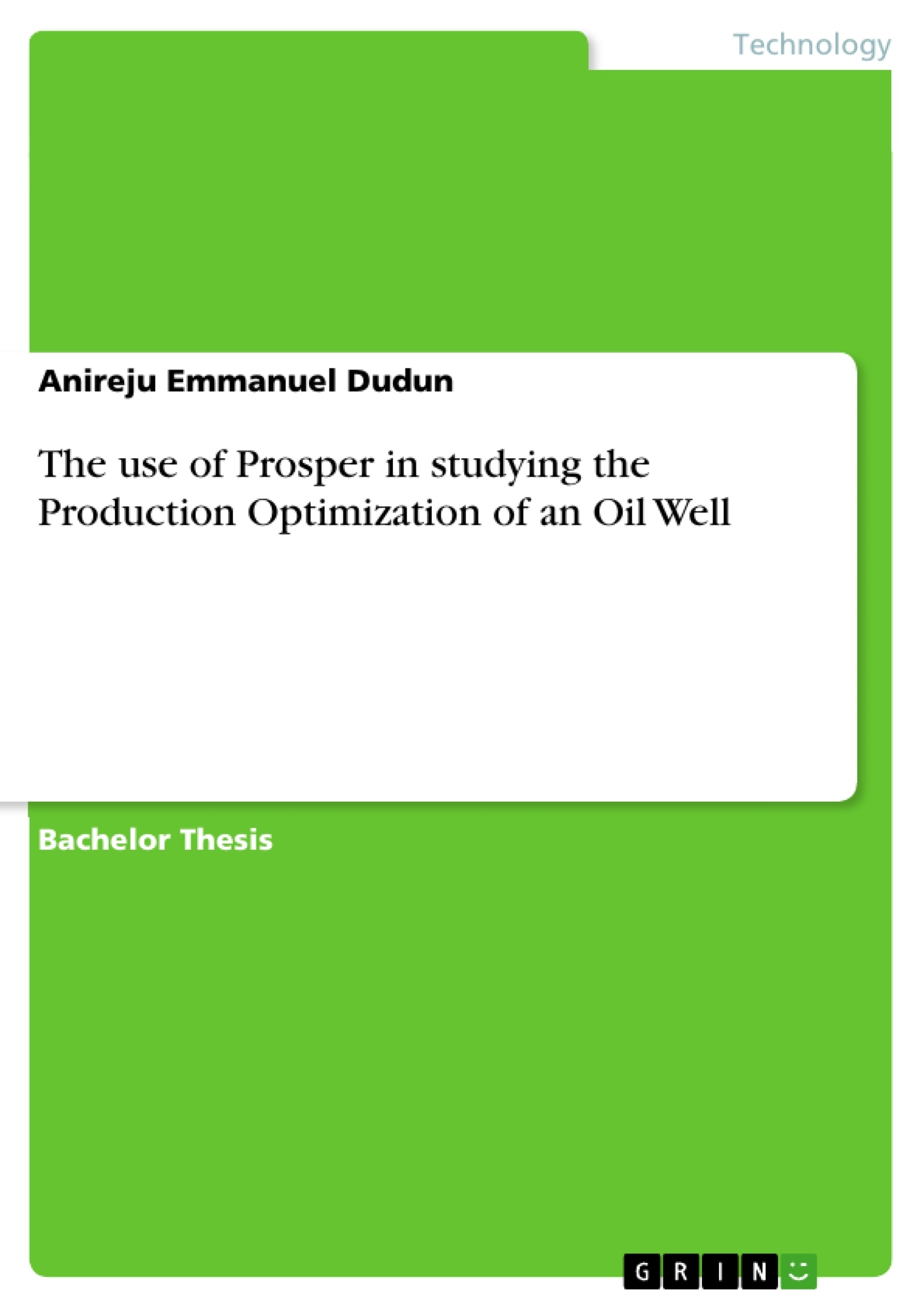Crude oil production is a major requirement to sustaining the well begins of any petroleum company. This will entail the effective placement of all facilities and equipment; surface or subsurface in order to achieve optimum volume of crude oil production, this is usually called production optimization.
In this study, the software prosper was utilized to case study well J-12T Well J-12T, a natural producer was producing at its peak oil rate at 6137 STB/d at 0% water-cut by mid-1973 but since then production has been on the decline due to increasing water-cut and decreasing reservoir pressure. But to date, the well is producing at an oil rate of 1431 STB/d at a water-cut of 50%.The VLP/IPR data were matched to well test flow rate measurement with a deviation of about 0,0534%, thereafter a short and long term optimization plan scenarios such as sensitivity runs on the well head pressure, tubing sizes, and gas lift technique respectively etc for the well, were simulated in PROSPER and then evaluated.
The results of this work suggests that; by lowering the Christmas tree pressure from 180 to 120psi the well’s life can be extended to 70% water-cut, also increasing the tubing size from 2,992" to 3,958" ID is also recommended. The gas lift method was found to be more economical as it can produce up to a maximum economic water cut of 90% with optimum gas injection rate of 3.3MMscf/d and oil production rates will increased from 1431 STB/d to about 3000 STB/d at 50% water-cut.
Table of Contents
- CHAPTER ONE
- 1.0 GENERAL INTRODUCTION
- 1.1 SCOPE OF STUDY
- 1.2 OBJECTIVE OF STUDY
- 1.3 MODALITIES OF STUDY
- 1.4 RESTRICTION(S) OF STUDIES
- CHAPTER TWO
- 2.0 NODAL ANALYSIS
- 2.1 NODAL ANALYSIS THEORY AND CONCEPT
- 2.2 INFLOW PERFORMANCE OF A WELL
- 2.2.1 DARCY'S EQUATION
- 2.2.2 PRODUCTIVITY INDEX (PI)
- 2.2.3 IPR CURVE
- 2.2.4 IPR IN SINGLE PHASE FLOW
- 2.2.5 IPR IN TWO PHASE FLOW
- 2.2.6 VOGEL'S EQUATION
- 2.2.7 FETKOVICH AND MULTIRATE FETKOVICH
- 2.2.8 JONES AND MULTI-RATE JONES
- 2.2.9 TRANSIENT
- 2.3 TUBING PERFORMANCE OF A WELL
- 2.4 CHOKE PERFORMANCE
- 2.5 GRADIENT CURVES
- 2.5.1 LIQUID FLOW RATE
- 2.5.2 GAS TO LIQUID RATIO (GLR)
- 2.6 OPERATING POINT
- 2.6.1 FAVOURABLE GLR
- 2.6.2 WATER CUT
- 2.7 MULTIPHASe FLOW
- 2.8 OVERVIEW OF THE GAS LIFT SYSTEM
- 2.8.1 FORMS OF GAS LIFT SYSTEMS
- 2.9 INJECTION GAS PRESSURE REQUIREMENT
- 2.9.1 GAS LIFT VOLUME REQUIREMENT
- CHAPTER THREE
- 3.0 HISTORY OF WELL J-12T
- 3.1METHODOLOGY
- 3.1.1 PROSPER'S SETUP FOR SENSITIVITY ANALYSIS
- 3.1.2 WORKING PROCEDURE FOR WELL MODEL SET-UP
- 3.1.3 OPTIONS SUMMERY
- 3.2 PVT DATA
- 3.2.1 PVT MATCHING PROCEDURES
- 3.2.2 REGRESSION
- 3.2.3 PARAMETERS
- 3.3 EQUIPMENT DATA
- 3.3.1 DEVIATION SURVEY
- 3.3.2 SURFACE EQUIPMENT
- 3.3.3 DOWNHOLE EQUIPMENT
- 3.3.4 GEOTHERMAL GRADIENT
- 3.3.5 AVERAGE HEAT CAPACITIES
- 3.4 GAS LIFT DATA
- 3.5 IPR DATA
- 3.6 MATCHING OF THE IPR MODEL
- 3.6.1 VLP MATCHING
- 3.6.2 IPR MATCHING
- CHAPTER FOUR
- 4.0 INTERPRETATION AND DISCUSSION OF SENSITIVITY ANALYSIS
- 4.1 SIMULATE BASE CASE FORECAST
Objectives and Key Themes
The project aims to study the production optimization of well J-12T using the Prosper software and a nodal analysis approach. The objective is to analyze the well's inflow performance, tubing performance, choke performance, and gas lift system performance. The project also aims to match the inflow performance relationship (IPR) model to the well's actual production data.
- Nodal Analysis and its application to well production optimization
- Inflow Performance Relationship (IPR) analysis and matching
- Gas lift system performance and optimization
- Sensitivity analysis and its role in production optimization
- Well production forecasting using the Prosper software
Chapter Summaries
- Chapter One: Introduces the project, outlining its scope, objectives, modalities, and restrictions. The project aims to use Prosper to optimize well J-12T's production using nodal analysis.
- Chapter Two: Explains the theory and concept of nodal analysis. It covers various aspects of well performance including inflow, tubing, choke, gradient curves, and gas lift systems.
- Chapter Three: Discusses the history of well J-12T and the methodology used for the sensitivity analysis. This includes setting up Prosper, working procedures for well model setup, PVT data matching, equipment data, gas lift data, and IPR data matching.
- Chapter Four: Focuses on the interpretation and discussion of the sensitivity analysis, including the simulation of the base case forecast.
Keywords
This project primarily focuses on the production optimization of oil wells, specifically well J-12T, using a nodal analysis approach and Prosper software. The key concepts and keywords are: nodal analysis, inflow performance relationship (IPR), gas lift systems, sensitivity analysis, production optimization, well performance, Prosper software, and well production forecasting.
- Quote paper
- Anireju Emmanuel Dudun (Author), 2014, The use of Prosper in studying the Production Optimization of an Oil Well, Munich, GRIN Verlag, https://www.grin.com/document/388079



